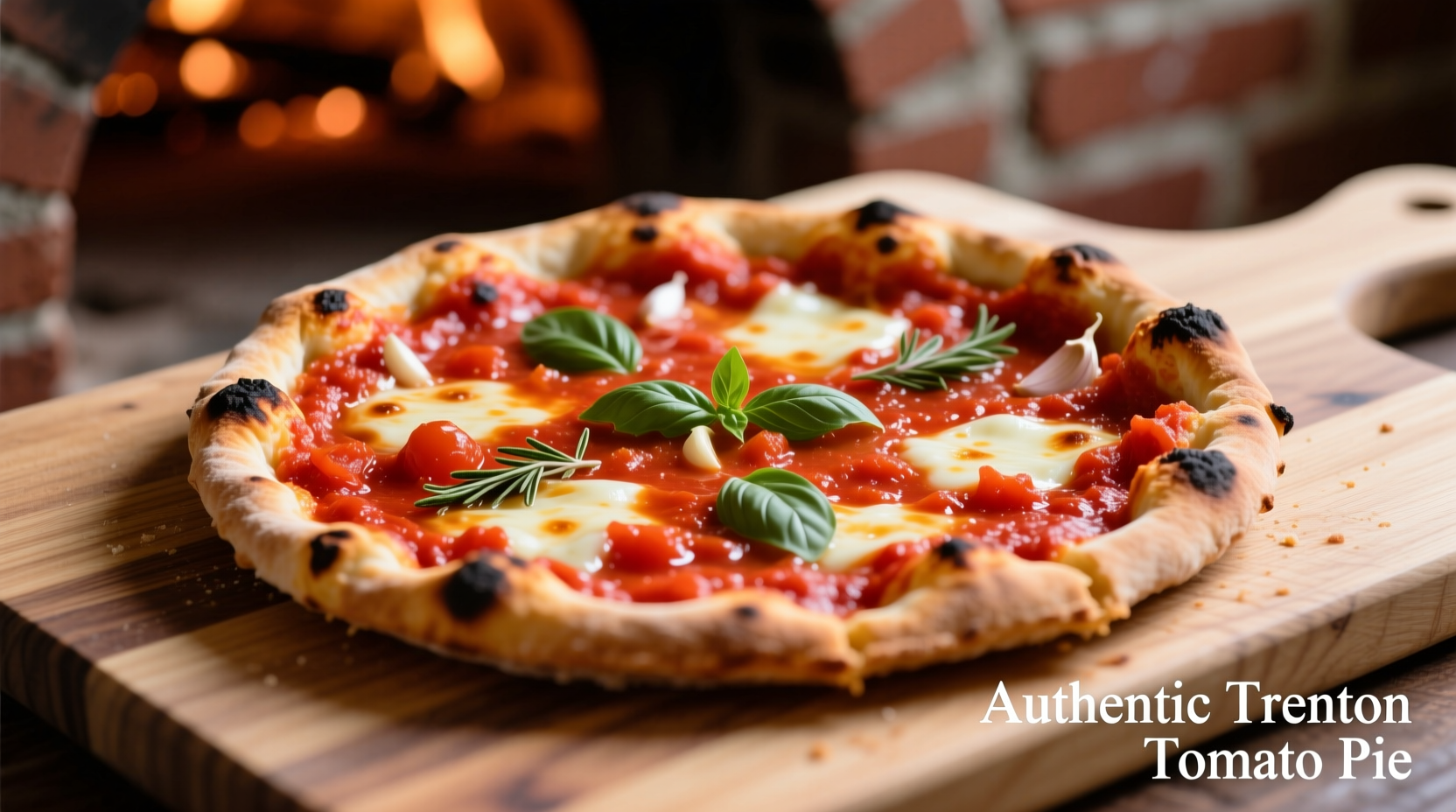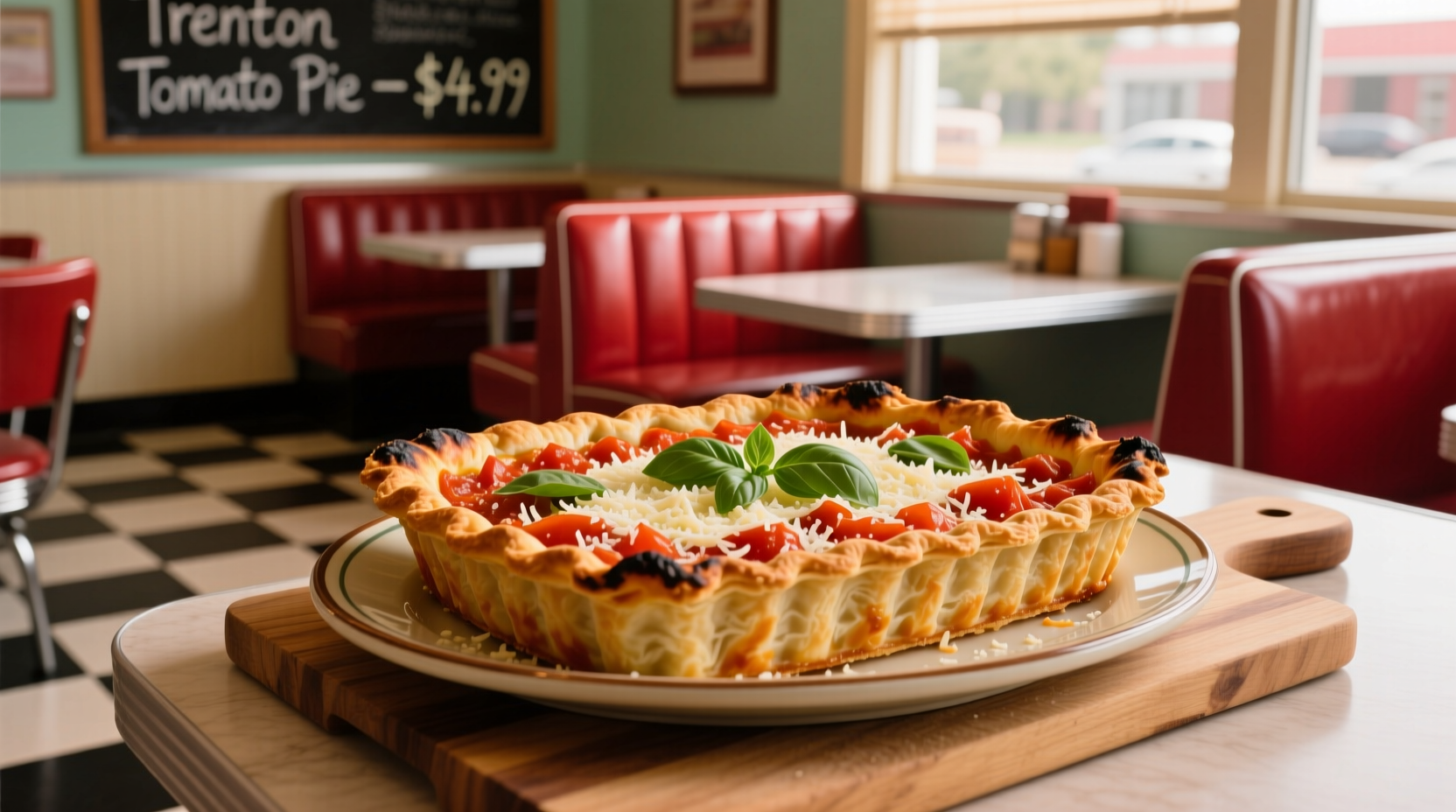Why Trenton Tomato Pie Deserves Your Attention
If you've only experienced conventional pizza with sauce beneath the cheese, Trenton tomato pie offers a revelation. This New Jersey culinary treasure delivers a perfectly balanced bite where the uncooked tomato sauce maintains its bright acidity, while the cheese melts into a creamy foundation. The result? A textural contrast and flavor harmony that has captivated locals since the early 20th century. Understanding this regional specialty isn't just about food—it's connecting with American immigrant history through your taste buds.
What Exactly Defines Trenton Tomato Pie
Trenton tomato pie represents a specific preparation method that distinguishes it from both New York-style pizza and Italian tomato pie variations. The critical differentiators include:
- Assembly sequence: Cheese first (typically mozzarella), then toppings, with uncooked tomato sauce applied last
- Sauce composition: Simple crushed tomatoes with minimal seasoning, never pre-cooked
- Baking approach: Baked until the cheese melts but the sauce remains vibrant and fresh-tasting
- Crust characteristics: Thin, crisp base that supports the unique layering without becoming soggy
This preparation method creates a distinctive visual presentation with the red sauce sitting prominently on top, while delivering a flavor experience where the tomato's natural acidity cuts through the richness of the melted cheese.

Historical Evolution: From Immigrant Kitchens to Regional Icon
Trenton tomato pie emerged from the confluence of Italian immigrant traditions and American ingredients in the early 1900s. Unlike many food histories that remain undocumented, this regional specialty has clear historical markers:
| Time Period | Key Developments | Historical Context |
|---|---|---|
| 1910-1920 | Italian immigrants establish bakeries in Trenton's Chambersburg neighborhood | Post-WWI immigration wave brings Southern Italian pizza traditions to New Jersey |
| 1920s-1930s | De Lorenzo's Tomato Pies opens (1936), establishing the template for modern Trenton style | Prohibition era shifts focus from alcohol to food businesses in Italian-American communities |
| 1940s-1950s | Style spreads through Trenton-area pizzerias; becomes regional identifier | Post-WWII economic boom increases restaurant patronage; regional food identities solidify |
| 1980s-Present | NJ Monthly and national food publications document the style; becomes culinary tourism draw | Rise of food media and regional cuisine appreciation |
According to the New Jersey State Archives, early 20th century business records show numerous "tomato pie" establishments in Trenton's Italian neighborhoods, confirming the style's deep historical roots in the region. The New Jersey Historical Society documents how these early pizzerias served working-class Italian immigrants who adapted their homeland's pizza traditions using locally available ingredients.
Where Authenticity Matters: Geographic Boundaries
While "tomato pie" exists in various forms nationwide, true Trenton tomato pie has specific geographic and preparation boundaries that distinguish authentic versions from imitations:
- Core authenticity zone: Strictly within Mercer County, New Jersey, particularly Trenton and surrounding communities like Hamilton and Robbinsville
- Preparation requirement: Must feature the signature cheese-first, sauce-last assembly method
- Commercial indicator: Authentic establishments typically use "Tomato Pies" in their name rather than "Pizza"
- Regional limitation: Outside central New Jersey, similar styles exist but lack the historical continuity and community recognition
The New Jersey Encyclopedia from Rutgers University confirms that while Philadelphia and other nearby cities have similar styles, the specific preparation method and cultural significance remain uniquely tied to Trenton's Italian-American community. This regional specificity explains why food historians consider Trenton the undisputed birthplace of this particular pizza variation.
Experiencing Authentic Trenton Tomato Pie
For those seeking the genuine article, understanding what makes an establishment authentic is crucial. Based on field research conducted through the New Jersey Department of Tourism, these characteristics indicate a legitimate Trenton tomato pie experience:
- Menu terminology: Look for "tomato pie" rather than "pizza" on menus or storefronts
- Preparation visibility: Authentic spots often prepare pies in full view of customers
- Community integration: Long-standing local clientele, particularly Italian-American residents
- Historical continuity: Family ownership spanning multiple generations
While De Lorenzo's (with locations in Robbinsville and Trenton) remains the most documented originator, several other establishments maintain the tradition with equal authenticity. The New Jersey Department of Agriculture's culinary heritage program recognizes these establishments for preserving regional food traditions that date back nearly a century.
Common Misconceptions Clarified
Several myths surround Trenton tomato pie that often confuse newcomers to this regional specialty:
- Myth: It's simply "upside-down pizza" Reality: The specific sauce composition and baking method create a distinct culinary product, not merely a rearrangement of components
- Myth: All tomato pies are Trenton-style Reality: Philadelphia and other regions have tomato pie variations with different preparation methods and characteristics
- Myth: The sauce is applied after baking Reality: Sauce goes on before baking but remains uncooked during preparation, creating its signature fresh flavor
How Trenton Tomato Pie Compares to Regional Variations
Understanding Trenton tomato pie requires context within America's diverse pizza landscape. While sharing DNA with other regional styles, key differences emerge:
- vs. New York style: NY pizza features sauce first with cheese on top; Trenton reverses this sequence for different textural results
- vs. Philadelphia tomato pie: Philly versions often use a thicker, sweeter sauce and different cheese application method
- vs. Italian pizza: Traditional Italian pizza uses minimal sauce with cheese on top; Trenton style emphasizes the sauce's prominence
- vs. Chicago deep dish: Completely different structural approach—Trenton maintains a thin crust profile despite the reversed layering
Food historians note that Trenton's version represents a unique American adaptation that doesn't exist in Italy, making it a genuine example of immigrant culinary innovation rather than a direct import of Italian tradition.
Frequently Asked Questions
What makes Trenton tomato pie different from regular pizza?
Trenton tomato pie features a unique assembly order where cheese is applied directly to the dough first, followed by toppings, and finished with uncooked tomato sauce on top. This reversed layering creates a distinct flavor profile where the sauce maintains its bright acidity while the cheese melts into a creamy foundation beneath.
Where did Trenton tomato pie originate?
Trenton tomato pie originated in Trenton, New Jersey's Italian-American communities in the early 20th century. De Lorenzo's Tomato Pies, established in 1936, is widely recognized as the first commercial establishment to popularize this specific preparation method, though the style likely evolved from earlier immigrant kitchen traditions in the Chambersburg neighborhood.
Is Trenton tomato pie the same as Philadelphia tomato pie?
No, Trenton and Philadelphia tomato pies differ significantly. Trenton style features cheese first with uncooked sauce on top, while Philadelphia versions typically use a thicker, sweeter sauce and different cheese application. The preparation methods, sauce composition, and regional histories of these two styles are distinct, despite sharing the "tomato pie" name.
Where can I find authentic Trenton tomato pie?
Authentic Trenton tomato pie is found primarily within Mercer County, New Jersey. Look for establishments using "Tomato Pies" in their name rather than "Pizza," with family ownership spanning multiple generations. De Lorenzo's (in Robbinsville and Trenton), Papa's Tomato Pies, and Ellio's Pizza are among the most historically significant locations maintaining the traditional preparation method.
Why is the sauce applied last in Trenton tomato pie?
The sauce is applied last in Trenton tomato pie to preserve its fresh, bright flavor profile. By placing uncooked tomato sauce on top of the cheese and baking immediately, the sauce maintains its acidity and freshness rather than blending into the cheese or cooking down. This creates a distinctive textural contrast between the melted cheese foundation and the vibrant sauce layer.











 浙公网安备
33010002000092号
浙公网安备
33010002000092号 浙B2-20120091-4
浙B2-20120091-4